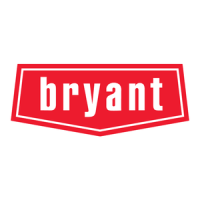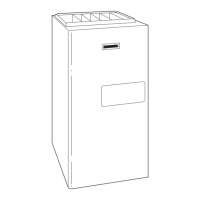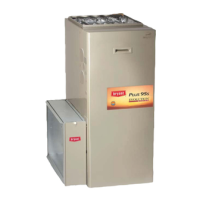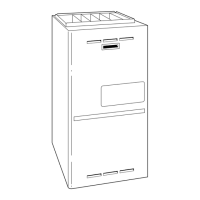2
Installing and servicing heating equipment can be hazardous due
to gas and electrical components. Only trained and qualified
service agency personnel should install, repair, or service heating
equipment.
A05085
Fig. 1 --- Furnace in Upflow Orientation
Untrained personnel can perform basic maintenance functions
described in User’s Information Manual such as cleaning and
replacing air filters. All other operations must be performed by
trained service personnel. When working on heating equipment,
observe precautions in the literature, on tags, and on labels
attached to or shipped with the unit and other safety precautions
that may apply.
CUT HAZARD
Failure to follow this caution may result in personal injury.
Be careful of sharp metal edges, etc. Use care and wear
protective clothing, gloves, and safety glasses when
removing parts.
CAUTION
!
Follow all safety codes including the National Fuel Gas Code
(NFGC) NFPA 54--2002/ANSI Z223.1 -- 2002 in the USA, CSA
B149.1--05 National Standard of Canada, Natural Gas and
Propane Installation Codes (NSCNGPIC) in Canada, and the
Installation Standards, Warm Air Heating and Air Conditioning
Systems (NFPA 90B) ANSI/NFPA 90B. Wear safety glasses and
work gloves. Have a fire extinguisher available during start-- up
and adjustment procedures and service calls.
GENERAL
This furnace must be installed as a direct vent (2-- pipe) or
ventilated combustion air condensing gas furnace (see installation
instructions for details). This furnace must be installed in an
upflow application. An upflow furnace application is where the
blower is located below the combustion and controls section of
the furnace, and conditioned air is discharged upward. (See Fig.
1 and 2.)
UPFLOW
AIRFLOW
A06340
Fig. 2 --- Approved Orientation
ELECTROSTATIC DISCHARGE (ESD)
PRECAUTIONS
UNIT DAMAGE HAZARD
Failure to follow this caution may damage furnace
components.
Electrostatic discharge can affect electronic components.
Take precautions during furnace installation and servicing
to protect the furnace electronic control. Precautions will
prevent electrostatic discharges from personnel and hand
tools which are held during the procedure. These
precautions will help to avoid exposing the control to
electrostatic discharge by putting the furnace, the control,
and the person at the same electrostatic potential.
CAUTION
!
1. Disconnect all power to the furnace. DO NOT TOUCH
THE CONTROL OR ANY WIRE CONNECTED TO
THE CONTROL PRIOR TO DISCHARGING YOUR
BODY’S ELECTROSTATIC CHARGE TO GROUND.
2. Firmly touch a clean, unpainted, metal surface of the fur-
nace chassis which is close to the control. Tools held in a
person’s hand during grounding will be satisfactorily dis-
charged.
3. After touching the chassis, you may proceed to service the
control or connecting wires as long as you do nothing that
recharges your body with static electricity (for example;
DO NOT move or shuffle your feet, DO NOT touch un-
grounded objects, etc.).
4. If you touch ungrounded objects (recharge your body with
static electricity), firmly touch furnace again before touch-
ing control or wires.
355BAV

